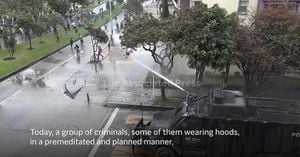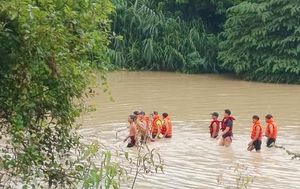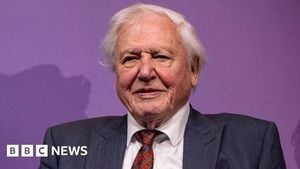On October 13, 2025, the courtyard of Nasser Hospital in Khan Younis, southern Gaza, became the epicenter of a moment both historic and harrowing. Tens of thousands of Palestinians gathered, some to welcome loved ones, others to bear witness, as nearly 2,000 Palestinian detainees were released by Israel as part of a ceasefire deal with Hamas. The scene overflowed with emotion—joy, tears, disbelief, and grief intermingled in the crowd, according to +972 Magazine. Over 1,700 of those released hailed from the Gaza Strip, their return marked by physical and psychological scars etched deep by weeks, months, or even years in Israeli detention.
Yet, as the buses arrived and detainees stepped out—emaciated, heads shaven, beards overgrown, and faces marked by suffering—the jubilation of release was shadowed by stories of loss and trauma. Many, still clad in gray prison uniforms, walked through ruined streets, their freedom bittersweet. "God has brought us back from the depths of the grave," several repeated, a phrase that seemed to capture both the torment of captivity and the euphoria of survival. But for some, the return home meant confronting unimaginable loss.
Haitham Moein Salem, a 43-year-old from Beit Lahiya, had been detained for over a year. In a cruel twist of fate, an Israeli airstrike on September 10, 2025, killed his wife and three children as they sheltered in what was supposed to be a safe zone. Salem had spent his time in prison preparing a small gift for his daughter Layan’s upcoming ninth birthday, only to learn five days before the celebration that she was gone. "No one informed me that my family had been targeted," Salem told +972 Magazine. "I began counting the days [in prison], hoping I would get out in time to celebrate her birthday. But today, just five days before it, I learned she had been martyred." Paramedics had to carry Salem away in a wheelchair when he heard the news, the weight of grief too much to bear.
Salem’s tragedy was heartbreakingly common among the newly released. Mohammad Assaliya, 28, detained during an Israeli ground invasion in Jabalia in January 2024, lost nearly his entire family—his parents and eight siblings—in a May 31 airstrike. Only one sister survived. "Freedom has a taste that cannot be described; our joy was beyond expression—but it shattered when I learned of my family’s martyrdom," he recalled to +972. Assaliya described the harrowing conditions in Israeli detention: deprivation of food and water, sleep denial, and a form of torture known as shabeh, where prisoners are bound and hung with their feet barely touching the floor. "Two days before our release, they gathered us onto buses and kept us there until we were freed. We weren’t allowed to eat or drink, and anyone who spoke to another detainee was beaten. It was a period of immense psychological pressure."
The physical toll of imprisonment was starkly visible in cases like that of Mahmoud Abu Foul, a 28-year-old from northern Gaza. Arrested at Kamal Adwan Hospital on December 27, 2024, Abu Foul emerged blind and suffering from severe inflammation in the stump of his amputated leg. "I was subjected to horrific torture. They held a wooden tool and constantly struck me from the front and back, sometimes simultaneously, which caused me to lose my sight," he told both +972 Magazine and Al Jazeera. Abu Foul believes he went blind about eight months before his release and received no medical treatment for his injuries. "All I want is just one eye back so I can see my family," he said, clinging to the hope of treatment abroad, as Gaza’s health system has collapsed.
Stories of psychological torture were equally devastating. Journalist Shadi Abu Sidwa, detained while seeking shelter at Al-Amal Hospital, recounted to +972 Magazine, "We were treated very badly, subjected to shabeh, beatings, and verbal, physical, and psychological humiliation." Prison authorities lied to him, claiming his wife and three children had been killed. "I left prison with an aching heart, imagining what my life would be like without my family—convinced they had all been martyred." Only upon his release did he discover his family was alive, a shock so profound he initially refused to believe it.
For others, the ordeal stretched over decades. Tareq Tabash, 45, spent 25 years in prison after his 2001 arrest. He described to +972 Magazine how conditions worsened since the war began on October 7, 2025: "Torture and punishment became policy. We were deprived of food, drink, and medicine, even those with chronic illnesses. The prisons were overcrowded. We were stripped of our belongings, and even the ability to speak to one another." Tabash, who earned a high school diploma and a bachelor’s degree while incarcerated, called on the international community to act: "The torture we endured—psychological, physical, and social—is beyond what anyone could imagine."
The suffering did not end with the living. According to Al Jazeera, most of the bodies of more than 100 dead Palestinians released by Israel remain unidentified, returned to Gaza with numbers instead of names. The bodies bore marks of torture, blindfolds, handcuffs, missing limbs, and signs of burning. Dr. Munir al-Bursh, director-general of the Gaza Health Ministry, wrote, "Crimes that cannot be hidden … This is how the bodies of Gaza’s prisoners were returned—blindfolded, bound like animals, and bearing signs of severe torture and burning." Forensic teams confirmed the abuse, and Palestinian organizations accused Israel of executing detainees while restrained—a charge Israel has denied but not substantiated with evidence.
Reports of torture in Israeli prisons have long been documented by rights groups. B’Tselem, the Israeli human rights organization, described the prison system as a "network of torture camps" in an August 2024 report, citing frequent violence, sexual assault, starvation, and denial of medical care. Al Jazeera also reported on the particularly egregious case of gang rape at the Sde Teiman detention facility, verified by video footage.
Even in the midst of this suffering, the released detainees and their families found themselves in a complex emotional landscape. Some, like 39-year-old Mahmoud Mohsen, criticized Hamas for delaying the ceasefire, believing it could have spared more lives and destruction. Others, including Ismail Al-Thawabtah, head of Gaza’s media office, emphasized that "the only achievement now is to halt the genocide. All we were thinking about was stopping the mass killing and destruction of our cities, regardless of the details of the deal."
Despite the mass release, nearly 9,000 Palestinians remain in Israeli prisons, including prominent leader Marwan Barghouti. Barghouti, compared by many to Nelson Mandela, has reportedly endured especially harsh treatment, including severe beatings, as detailed by his son Arab to Al Jazeera. Far-right Israeli officials have openly defended the harsh conditions, with National Security Minister Itamar Ben-Gvir stating that "summer camps and patience for the terrorists are over."
As the dust settles on this latest exchange, the stories of those released—and those who never made it home—stand as stark reminders of the human cost of conflict. The scars, both visible and invisible, will linger long after the crowds have dispersed from Nasser Hospital’s courtyard.




